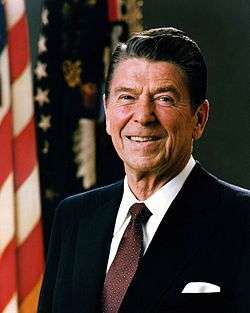Executive Order 12333

On December 4, 1981, U.S. President Ronald Reagan signed Executive Order 12333, an Executive Order intended to extend powers and responsibilities of U.S. intelligence agencies and direct the leaders of U.S. federal agencies to co-operate fully with CIA requests for information.[1] This executive order was entitled United States Intelligence Activities.
It was amended by Executive Order 13355: Strengthened Management of the Intelligence Community, on August 27, 2004. On July 30, 2008, President George W. Bush issued Executive Order 13470[2] amending Executive Order 12333 to strengthen the role of the DNI.[3][4]
Part 1
"Goals, Direction, Duties and Responsibilities with Respect to the National Intelligence Effort" lays out roles for various intelligence agencies, including the Departments of Defense, Energy, State, and Treasury.
Part 2
"Conduct of Intelligence Activities" provides guidelines for actions of intelligence agencies.
Collection of Information
Part 2.3 permits collection, retention and dissemination of the following types of information along with several others.
"(c) Information obtained in the course of a lawful foreign intelligence, counterintelligence, international narcotics or international terrorism investigation"[1]
"(i) Incidentally obtained information that may indicate involvement in activities that may violate federal, state, local or foreign laws"[1]
Proscription on assassination
Part 2.11 of this executive order reiterates a proscription on US intelligence agencies sponsoring or carrying out an assassination. It reads:[5]
No person employed by or acting on behalf of the United States Government shall engage in, or conspire to engage in, assassination.
Previously, EO 11905 (Gerald Ford) had banned political assassinations and EO 12036 (Jimmy Carter) had further banned indirect U.S. involvement in assassinations.[6] As early as 1998, this proscription against assassination was reinterpreted, and relaxed, for targets who are classified by the United States as connected to terrorism.[7][8]
Impact
Executive Order 12333 has been regarded by the American intelligence community as a fundamental document authorizing the expansion of data collection activities.[9] The document has been employed by the National Security Agency as legal authorization for its collection of unencrypted information flowing through the data centers of internet communications giants Google and Yahoo!.[9]
In July 2014 chairman David Medine and two other members of the Privacy and Civil Liberties Oversight Board, a government oversight agency, indicated a desire to review Executive Order 12333 in the near future, according to a report by journalist Spencer Ackerman of The Guardian.[9]
In July 2014, former State Department official John Tye published an editorial in The Washington Post, citing his prior access to classified material on intelligence-gathering activities under Executive Order 12333, and arguing that the order represented a significant threat to Americans' privacy and civil liberties.[10]
See also
Footnotes
- 1 2 3 Ronald Reagan, "Executive Order 12333—United States Intelligence Activities," US Federal Register, Dec. 4, 1981.
- ↑ "Executive Order 13470". Fas.org. Retrieved May 6, 2011.
- ↑ "Bush Orders Intelligence Overhaul", by Associated Press, July 31, 2008
- ↑ Executive Order: Further Amendments to Executive Order 12333, United States Intelligence Activities, White House, July 31, 2008
- ↑ "Executive Orders". Archives.gov. Retrieved May 6, 2011.
- ↑ CRS Report for Congress Assassination Ban and E.O. 12333: A Brief Summary January 4, 2002
- ↑ Walter Pincus (February 15, 1998). "Saddam Hussein's Death Is a Goal, Says Ex-CIA Chief". The Washington Post. p. A36. Archived from the original on December 30, 2008. Retrieved December 30, 2008.
- ↑ Barton Gellman (October 21, 2001). "CIA Weighs 'Targeted Killing' Missions: Administration Believes Restraints Do Not Bar Singling Out Individual Terrorists". The Washington Post. p. A01. Archived from the original on December 30, 2008. Retrieved December 30, 2008.
- 1 2 3 Spencer Ackerman, "NSA Reformers Dismayed after Privacy Board Vindicates Surveillance Dragnet: Privacy and Civil Liberties Oversight Board Endorses Agency's So-called '702' Powers, Plus Backdoor Searches of Americans' Information", 'The Guardian (London), July 2, 2014.
- ↑ Farivar, Cyrus (August 20, 2014). "Meet John Tye: the kinder, gentler, and by-the-book whistleblower". Ars Technica.
Further reading
- Full text
- Ronald Reagan, "Executive Order 12333—United States Intelligence Activities", US Federal Register, December 4, 1981.
External links
| Wikisource has original text related to this article: |
- Metadata concerning Executive Order 12333, US Federal Register – indicates other executive orders that this E.O. amends, revokes, and is amended by.
- Executive Order 12333 Documents Redefine 'Collection,' Authorize Majority Of Dragnet Surveillance Programs, Techdirt, 2014/09/29
- Should U.S. officials say anything that could harm U.S. soldiers?, Milnet – (a 5k summary of eo12333)
- Executive Order 13355: Strengthened Management of the Intelligence Community, White House, August 27, 2004.
- Executive Order 13355: Strengthened Management of the Intelligence Community, US Federal Register, September 1, 2004.
- Procedures Governing the Activities of DoD Intelligence Components that Affect United States Persons, December 1982.
- Another Law Under Assault, Washington Post, September 29, 2005.
- Hess, Pamela (November 8, 2002). "Experts: Yemen strike not assassination". UPI.
- Elizabeth B. Bazan (January 4, 2002). "Assassination Ban and E.O. 12333:A Brief Summary" (PDF). CRS Report for Congress. Retrieved April 26, 2006.
- Tom O'Connor, Mark Stevens (November 2005). "The Handling of Illegal Enemy Combatants". Archived from the original on May 5, 2006. Retrieved April 26, 2006.
- "Memorandum on Executive Order 12333 and Assassination" (PDF). Retrieved April 26, 2006.
- Jeffrey Addicott (November 7, 2002). "The Yemen Attack: Illegal Assassination or Lawful Killing?". JURIST. Retrieved April 26, 2006.